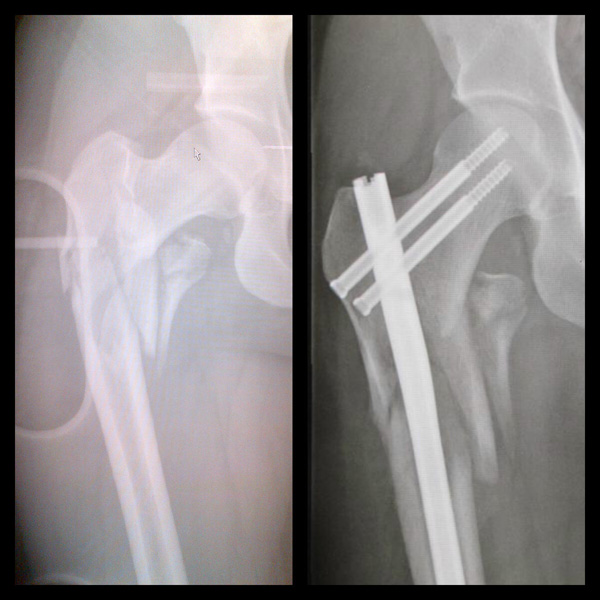Kim Howard was out on the lake at a friend’s cottage in Haliburton for a ride on a jet ski, when an unfortunate accident involving another jet ski left her in a hospital bed wondering what the future would hold. From that moment forward Kim’s life changed forever, and she began a courageous and challenging rehabilitation journey that would test her mental will and her body’s ability to recover.
As an employee of Merrithew®, Kim knew that Pilates could be beneficial in her recovery. Luckily for her, she was given access to Wayne Seeto, a Merrithew Rehab Master Instructor Trainer and therapist, and thus began a structured Pilates program in conjunction with her traditional physical therapy. The combination has allowed her to become stronger, pain free and healthier than she could have ever imagined.

Kim and her best friend the day before her accident

Kim’s X-ray post-surgery
Kim’s injuries included five fractures to her right femur. Surgery immediately followed the accident where a titanium rod was inserted inside the full length of her femur with two screws on each end. After months of complete immobility followed by a second corrective surgery, Kim was ready to start her rehabilitation. Her Pilates program followed closely the phases of the rehab process and the specific exercises and approach kept the same goals in mind. At each stage of rehabilitation, her Pilates instructor introduced movements that allowed her to progress at a measured pace.
Kim’s specific goals were to re-develop a strong and streamlined body again and to be able to run, jump, get back into regular workouts and play volleyball again. As a former model Kim was also hoping that by being able to more actively engage in sports and fitness again that she would regain her figure and get back on the runway.
Phase 1: Acute Rehab
- Occurs immediately after an injury or surgery
- Work can only be done by a registered therapist
- One-on-one treatment is most effective
- Work is primarily focused on the affected area of the body
Kim’s Treatment
- Kim began her traditional therapy with several physical therapists working primarily on the injured leg with low-load, proprioceptive exercises that helped increase range of motion and ability to weight bear on the injured knee and hip.
Phase 2: Post-Acute/ Post-Rehab
- Occurs when there is improvement at the site of the injury
- Likely still one-on-one treatment
- More integrative work by the therapist to deal not only with the injured area, but also the integration of the affected joint or part with the rest of the body
- At this stage, Pilates programming is introduced focusing on eccentric control of the injured region with a multitude of movements incorporating Matwork and Equipment based exercises.
Kim’s Treatment
-
In addition to sessions with her Sports Chiropractor Dr. Davor Cepo where she did acupuncture and Active Release Technique, Kim began working with Wayne Seeto, Master Rehab Instructor Trainer at the Merrithew Toronto Corporate Training studio. Wayne collaborated with Kim’s therapist to ensure they were working together to provide her with seamless continuity of care, and that her exercise and post-rehab needs were being met.
-
Kim’s STOTT PILATES program and sessions focused on four elements of joint stability; form closure (posture and position of the passive structures of the joints), force closure (contractile elements of the joints, including muscle length, strength and endurance), motor control (the neurological system, muscle activation, timing and coordination) and her emotions and awareness (which reflect previous motor patterns and movement experiences, along with mindfulness of appropriate movement and dysfunction).
- Low to moderate loaded resistance exercises with proprioceptive devices like Reformer accessories, Mini Stability™ Ball, the Halo® Trainer and the Pilates Edge were added to workouts to improve sensory input to engage the motor control system more effectively.
Phase 3: Ongoing Conditioning
- Focused on strength building, postural stability and prevention of injury recurrence
- Can be small group-based- no longer needs to be one-on-one
- Indefinite length of treatment
- Pilates programming starts to build on the strength and stability gains that the patient has made in the previous phases.
Kim’s Treatment
- Several other Instructor Trainers joined Wayne in working with Kim and her therapist.
- Sessions started to include plyometric training such as Cardio-Tramp® Rebounder and Jumpboard exercises on the Reformer to mobilize the hip under increased load of the pelvis on the femur and was used as a precursor to functional training for running
- Intensity continued to increase and gains to her workout tolerance were noted
- Special attention continues to be placed on ensuring that compensatory strategies are caught early and proper biomechanical and neuromuscular patterns are reinforced.
Kim is committed to continuing her Pilates training along with her ongoing therapy, although each has decreased in frequency while increasing in intensity. By maintaining her focus on each element, she is on track to reach her fitness goals in the near future.
It is very important that Pilates Instructors and health-care professionals speak the same language in order to provide continuous care with the same goals in mind. Instructors who have received pertinent education and work to continuously upgrade their skills and who have been exposed to a variety of special situations carry a wealth of knowledge and experience and are able to competently integrate their skills into the therapeutic process, resulting in a really positive outcomes for their clients.
Movement professionals who aspire to working in the post-rehab environment should consider taking further studies in the STOTT PILATES repertoire. For information on the Injuries & Special Populations course (ISP), click here. For information on the Post-Rehabilitation Conditioning Specialty Track, click here.
Healthcare professionals who want to learn more about the STOTT PILATES Rehabilitation program and how it can benefit your clients, click here.